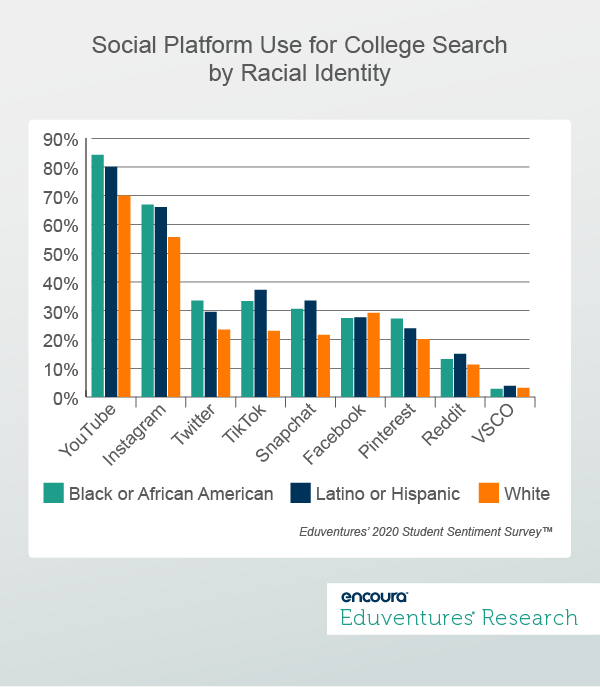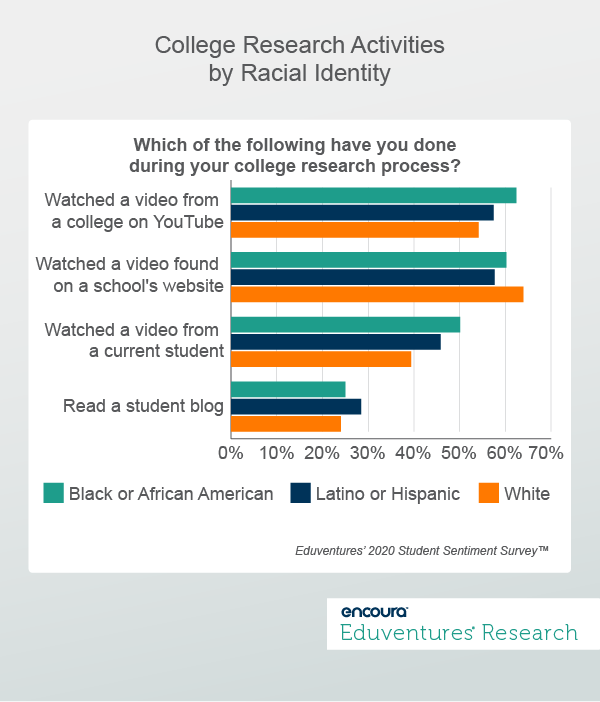The renewed national focus on racial inequity has made its way into the halls of U.S. colleges and universities. Often touted as the “Great Equalizer,” institutions of higher education have long-strived to create diverse campus communities, increase equity, and offer social mobility to underserved student populations.
Insufficient progress, however, has been made in the representation of racial minorities on the vast majority of college campuses. While there are many reasons for this, they all begin with recruitment. Many institutional leaders, particularly at selective institutions, say they continue to struggle to attract students of color.
Eduventures’ Student Sentiment Survey™ indicates that . But using it differently can be a challenge.
Getting the Most Out of Social Media
Every year, Eduventures invites college-bound high school students across the country to tell us about their college search behaviors and outreach preferences. In 2020, we received more than 5,800 responses to our Student Sentiment Survey from high school seniors, juniors, and sophomores.
Our study shows that social media plays a critical supporting role in recruiting efforts. But rather than asking how many prospective students can be reached via social platforms, the more important question might be which students. Figure 1 below breaks out social platform use for college search among respondents who identify as Black or African American (13%), Hispanic or Latino (19%), and white (43%), the three largest racial categories in our survey sample.
It should be noted that, while students were able to select as many racial and ethnic categories with which they identified, to avoid overlap between the categories, our current analysis focuses on students who only identified with one race.

While all students use YouTube most often in their college searches, the proportion of students of color is significantly larger (84% Black or African American, 80% Latino or Hispanic vs. 70% white). The pattern is the same for the second most-used platform, Instagram, with the largest gap again being between Black or African American students (67%) and white students (55%). Only Facebook is used at a similar rate among all three racial categories, but fewer than a third of all students (28%) use it at all in their college searches.
Generally, students who identify as Black or African American or Latino or Hispanic are more likely to visit social media platforms in their college searches, and Black or African American students in particular are more likely to have “followed” or “liked” a college on social media (61% vs. 54% Latino or Hispanic or white).
Your World through Their Eyes
What is the reason for these differences in social media use? Most likely, it has to do with access to other information sources. White students are more likely to say they first learned about a school by talking to family and friends (64% vs. 49% Black or African American and 47% Latino or Hispanic), receiving postcards and brochures from schools (54% vs. 42% and 45%, respectively), and knowing current students or alumni (39% vs, 36% and 31%). They are also less often first generation students (31% vs. 45% and 76%) and less likely to report household incomes below $50,000 (13% vs. 29% and 40%). This family support, financially and otherwise, means that white students are more likely to be able to assess fit by visiting campuses or hearing accounts of first-hand experiences.
This may leave many students of color with social media as an especially important means of determining fit. Past Eduventures research has shown that prospective students, regardless of racial background, use social media in their college searches primarily to assess whether they can see themselves on campus. Black or African American students, in particular, seem to embrace YouTube for this purpose. They are more likely to have first learned about a school on YouTube (27% vs. 22% Latino or Hispanic, and 17% white). And they continue to rely on the platform in their searches, as Figure 2 shows, watching both institutionally curated (63%) as well as student videos (50%).

Given these findings, the roadmap to reaching students of color seems a little clearer: increase the institutional social media profile, especially on video-based platforms. Unfortunately, this is where things can, and often do, go wrong. Many institutions struggle to create the right content. Tasked with reaching new markets while not alienating the “bread and butter” students, marketing offices create videos that show the campus based on the institutional identity the school wants to convey. That usually means we see happy students having fun on campus, participating in stimulating academic activities, and building meaningful futures for themselves.
The problem: more often than not, the students who are prominently featured in this promotional content are white, while students of color play a minor role. The school wants to convey that diversity exists on campus but not “too much” diversity. This approach will likely not suffice to convey the right fit for many students of color.
The Bottom Line
Institutions that are serious about increasing racial diversity will find a helpful tool in social media platforms. For many schools, however, this also means they will need to manage their social platforms differently than they have in the past. The messages conveyed on these channels may no longer be crafted to reach the broad masses. Tailored messaging is necessary to address a desired audience.
This can be an uncomfortable process. What appeals to some students might deter others. Schools that are truly interested in creating a more diverse campus community will need to leave the comfort zone of institutional habit and personal implicit biases to critically evaluate their carefully-curated recruitment videos. Here are some questions to consider in the process:
- What kind of community and opportunities do students of color see in our videos?
- Is what we show a true reflection of the experience these students have on our campus?
- Do we need to make any changes so that we can deliver what we promise?
- Are we willing to make these changes if it means we might attract fewer of our majority student segments?
It is easy to aspire to change, but change can be difficult to implement. You have the tools. How will you use them?
Never Miss Your Wake-Up Call
Learn more about our team of expert research analysts here.
Eduventures Senior Analyst at ACT | NRCCUA
Contact
The annual CHLOE (Changing Landscape of Online Education) survey chronicles the evolution of online policies and practices in U.S. higher education, from the perspective of Chief Online Officers (COOs). The fifth CHLOE survey captures leadership reflections on the pandemic-induced emergency remote instruction in the spring: what happened, what worked, and implications for fall. The CHLOE 5 report is published amid a coronavirus spike that is persuading many colleges and universities to re-think their fall re-opening plans.
This webinar will distill lessons from the spring and, in conversation with a panel of online leaders, gauge early fall realities. Online infrastructure, experience and leadership played a pivotal role in enabling schools to see through the last academic year, but many leaders have been quick to draw a distinction between hastily assembled “remote instruction” and true online learning. As fall 2020 gets underway, and schools face a yet stiffer test, online leaders are stepping up once again. Robust, engaging, high quality remote learning, by whatever name and whether or not combined with a socially distanced campus, will define this one-of-a-kind semester.

